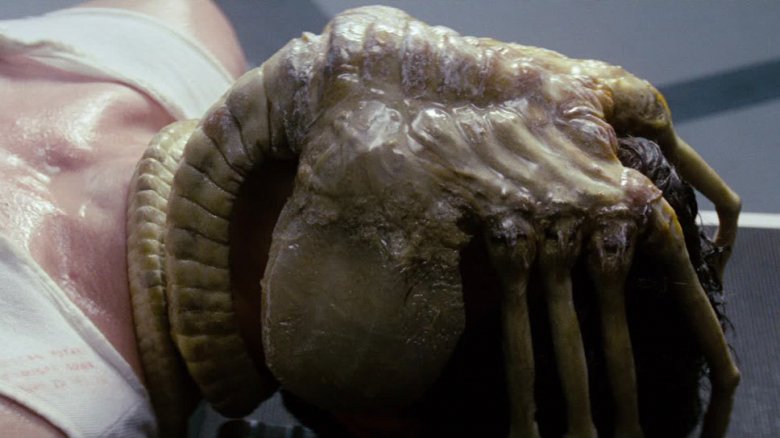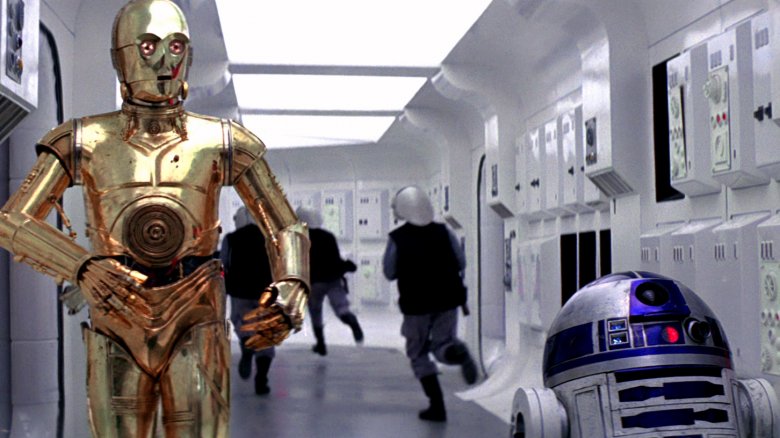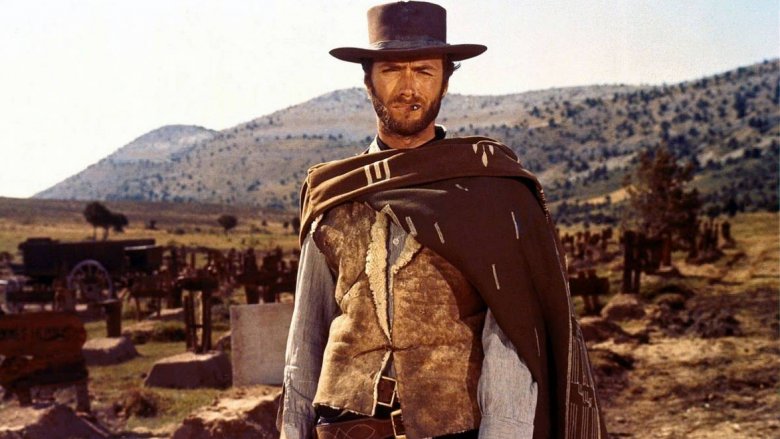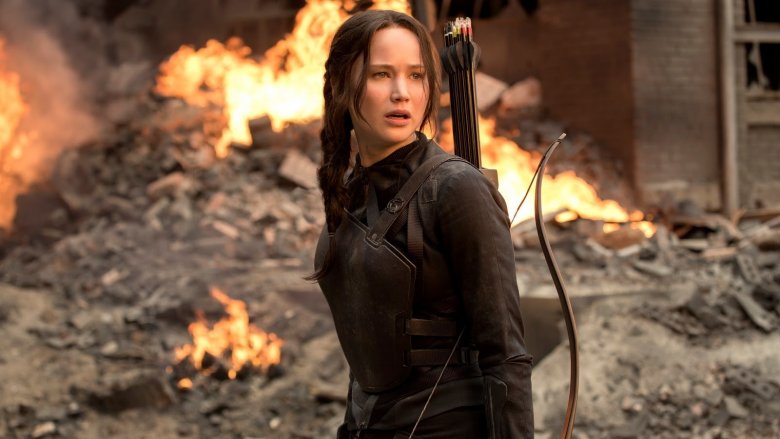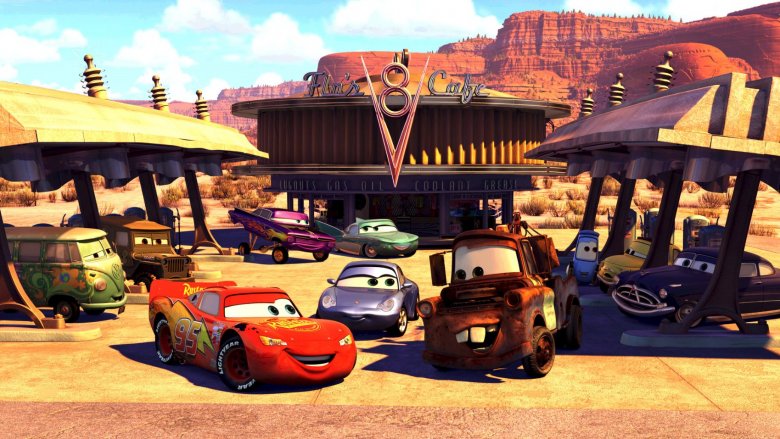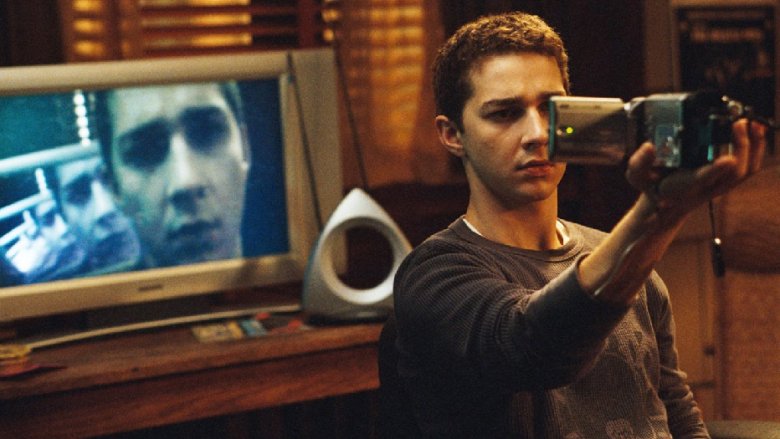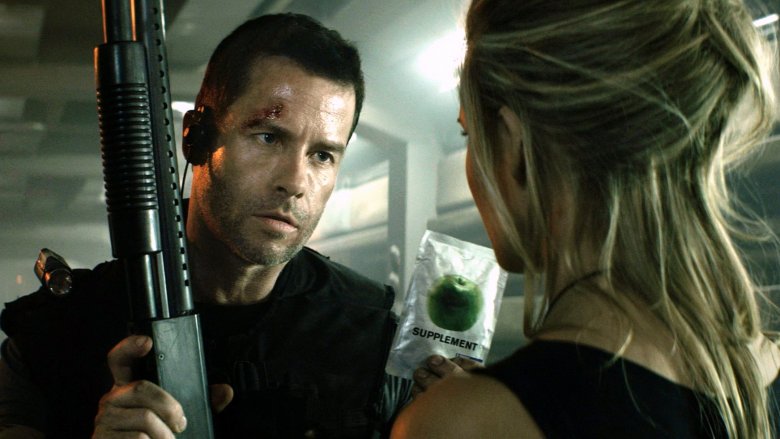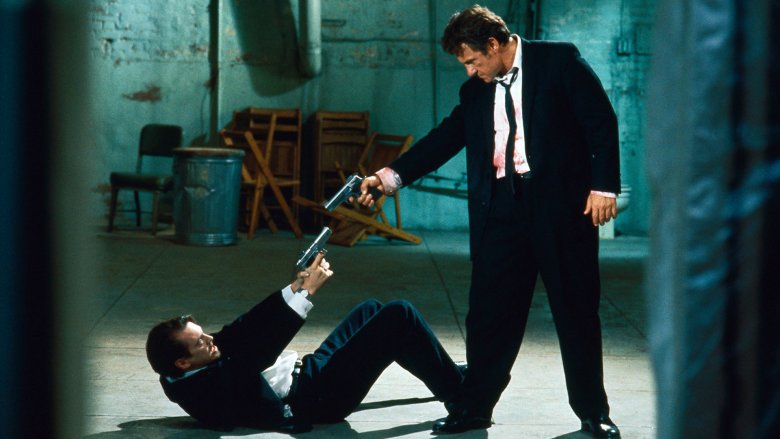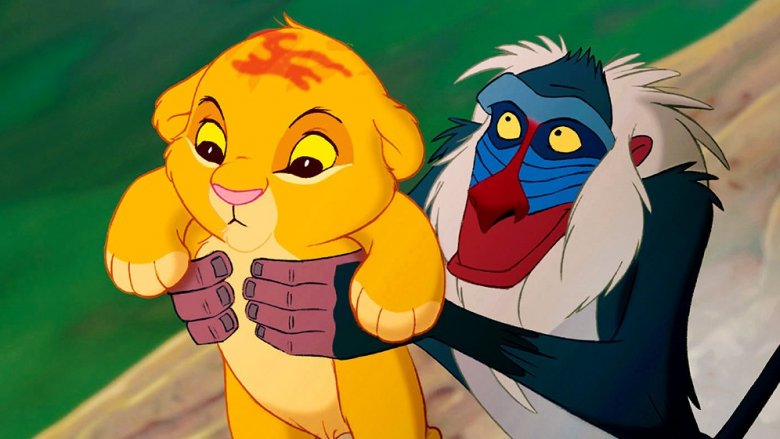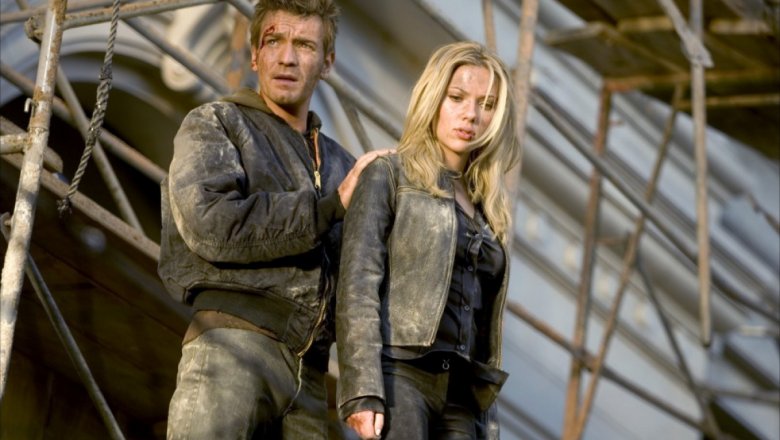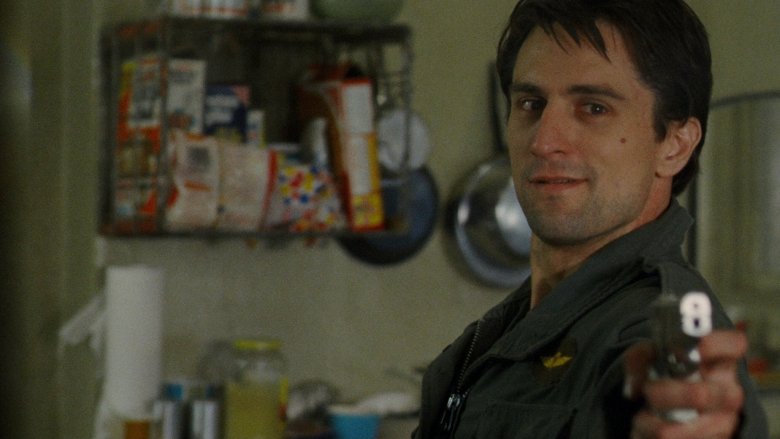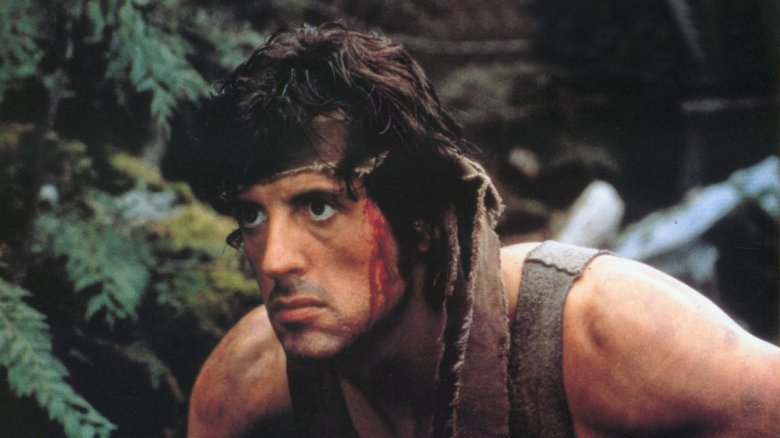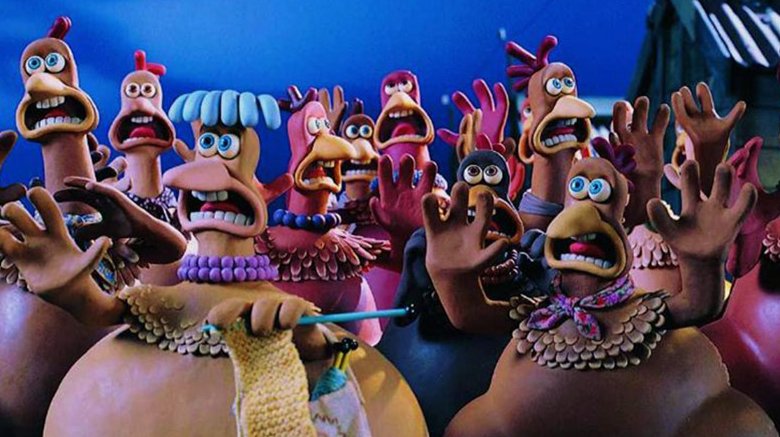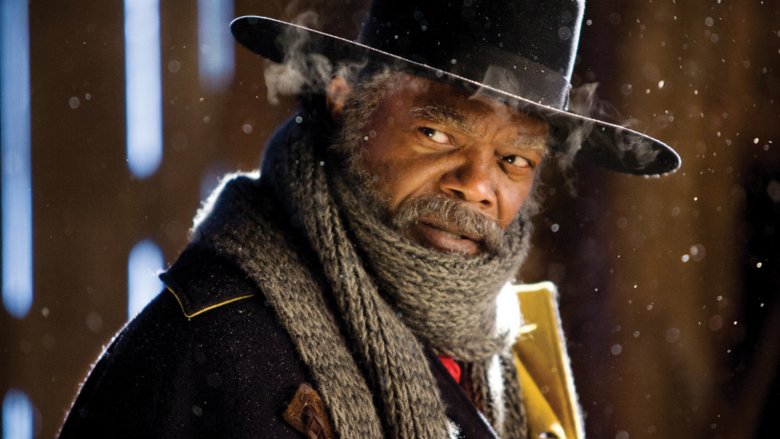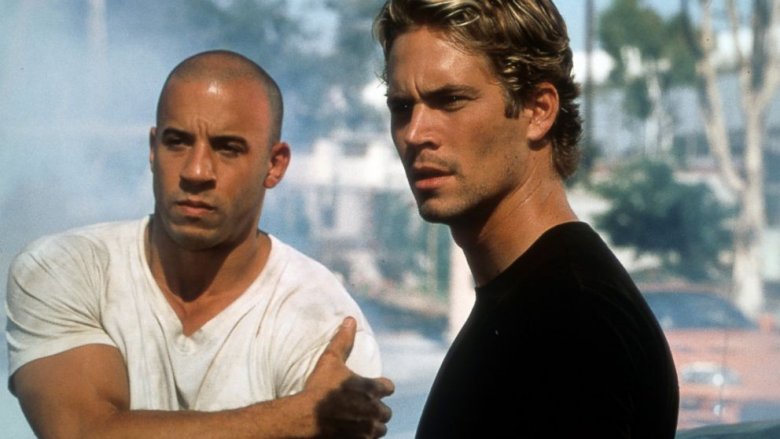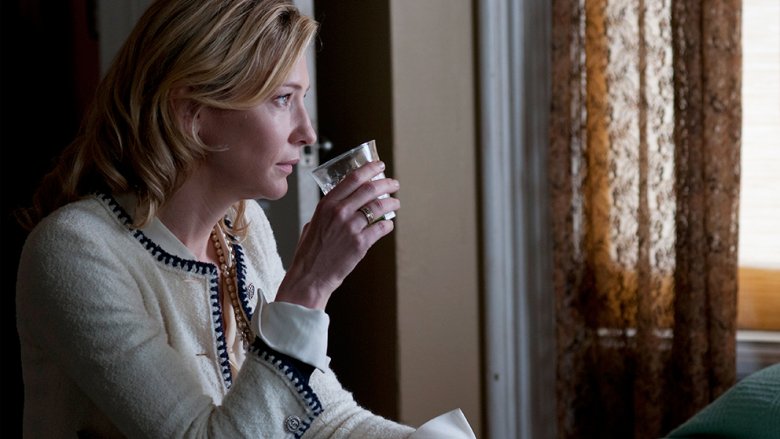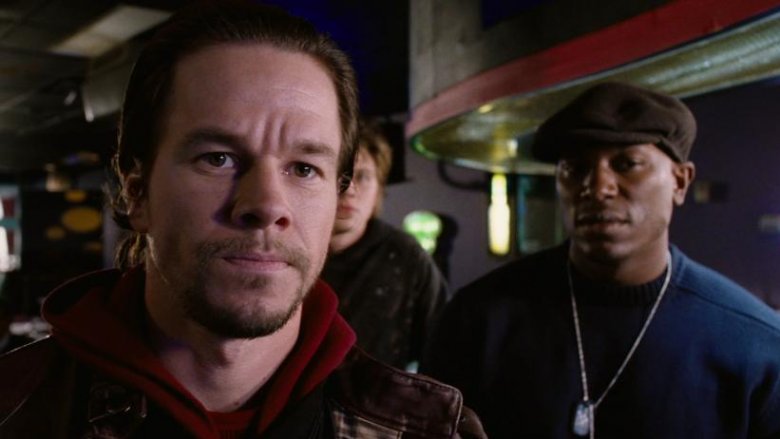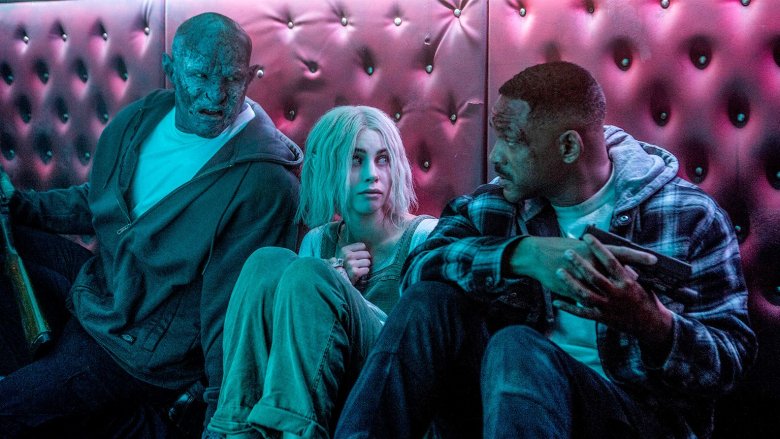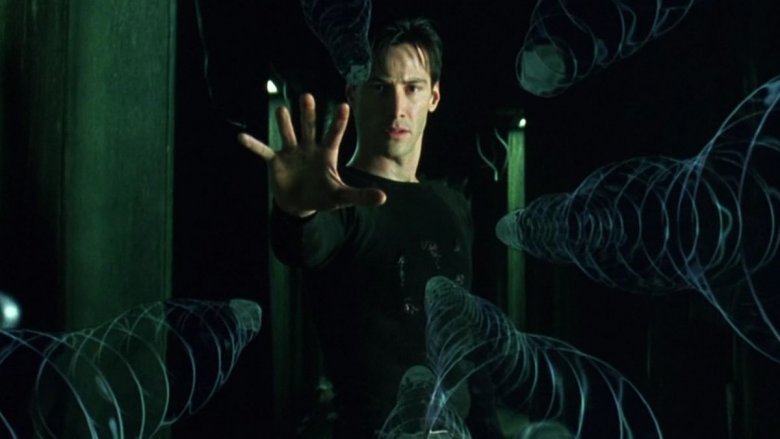Plots That Were Stolen From Other Movies
It's all but impossible to tell a truly original story. After over a century of cinema—not to mention hundreds of years of storytelling that predates recorded history—it's safe to say virtually every possible premise has already been covered. But some movies don't even attempt to be even a little original, stealing their plots almost wholesale from films that came before. Here are some classic movies that are all but carbon copies of other films.
Alien / It! The Terror from Space
No one's claiming Alien was the first movie ever about evil aliens, but it's amazing just how much it owes to the 1958 B-movie schlockfest It! The Terror From Space.
Both movies have the exact same setup—a ship lands on an alien planet and is invaded by a hungry, violent, uncontrollable local who gets to killing almost immediately. In both movies, it hides in an air shaft, gets thwarted by a blowtorch, then dies in the vacuum of space. Not that the people behind Alien will admit to the inspiration: when speaking with Glenn Lovell of the Fort Lauderdale Sun-Sentinel, producer David Giler denied his film was a ripoff, only saying that Alien's hook of the creature killing from inside the ship was "pretty much a classic premise with science fiction writers, like the gunfight in the Western." In other words, call him unoriginal, but don't you dare call him a thief.
At the same time, he threw writer Dan O'Bannon under the bus, saying his original draft was terrible and nothing but a ripoff of 1950s sci-fi. As Giler put it, "It wouldn't surprise me at all to learn that Dan O'Bannon stole the idea." The fact that the final version—the one Giler claims was written mostly by himself and others not named O'Bannon—is almost It, beat-for-beat, is probably just a total coincidence, right?
Star Wars / The Hidden Fortress
It's no secret George Lucas didn't create Star Wars out of thin air—he's worn his sci-fi and samurai influences on his sleeve from the start. Still, there's that, and then there's thievery, and it seems Lucas was extremely guilty of the latter.
Star Wars almost certainly wouldn't have existed without Akira Kurosawa's 1958 samurai epic The Hidden Fortress. Even Lucas himself admits as much—kind of. He's openly mentioned his love for the way Fortress told its story through the eyes of "the two lowest characters." For Fortress, that was two argumentative peasants, while in Star Wars, it was the droids C-3PO and R2-D2. If narrative style were all the two films had in common, that'd be one thing, but the Star Wars story as a whole is basically Fortress in space. There's a civil war brewing, a badass fighting princess that needs escorting back to safety, a fat Jabba-esque slave driver, and a disfigured villain who sees the light at the end. Fortress even features the horizontal scene-wipes that Star Wars made famous. Basically, the only real differences are that the lowly peasants in Fortress are in it for the money, and Kurosawa never thought up anyone as annoying as Jar-Jar.
Even the post-Lucas Star Wars owe a hand to Fortress: Rey's staff looks a lot like the ones used by Fortress's generals, and her fighting stances look like theirs as well. That, however, seems more like an homage than "suspiciously heavy lifting."
A Fistful of Dollars / Yojimbo
George Lucas isn't the only filmmaker to steal from Akira Kurosawa, but he can thank his lucky stars that he wasn't one of the people Kurasawa sued for theft. Sergio Leone, director of A Fistful of Dollars, wasn't quite so fortunate.
1964's Dollars, as explained by LA Weekly, was almost a total remake of Kurosawa's 1961 samurai classic Yojimbo. Both featured the exact same story: a quiet loner comes to a small town where two gangs are fighting for control, he casts himself as a double agent working for both sides, he winds up killing basically everyone, and then he rides off with a fabulous cash reward. Both also took the same approach to the Western genre—making it gritty and dark, turning the good guys into slightly nicer bad guys, and utilizing multiple close-ups of the characters' faces to up the intensity. The quiet loner goes without a name in both, too. So you can see why Kurosawa saw red when he saw Dollars, saying, "It is a very fine film, but it is MY film."
Kurosawa didn't just see red, though; he saw green. According to Side B Magazine, he sued Leone for plagiarism, and eventually won because there was no way he couldn't. Leone wound up paying Kurosawa 15 percent of Fistful's royalties, plus a cool $100,000. Unlike his movie's hero, Kurosawa didn't need to kill anyone to earn a fistful (or rather, a truckload) of dollars—he simply had to make a film so good Hollywood couldn't help but pilfer.
Hunger Games / Battle Royale
The Hunger Games is a legitimate cultural phenomenon, but it only got that way by lifting its central premise from another film, then sanitizing it for your protection.
As the New Yorker points out, Hunger Games owes its entire existence to the 2000 Japanese movie Battle Royale—both feature a dystopian society where children are drafted into fighting each other to the death for the amusement of older, more powerful rulers. But Hunger Games takes that concept and somehow makes it as nonviolent and PG-13 as possible, whereas Battle Royale reveled in the violence. The kids in Hunger don't really want to fight but do so anyway, where in Battle they relish the chance. Any kid who speaks up against the violence is killed almost immediately, with their murderers loudly and proudly announcing their deaths to all the others, as both a proclamation and a warning. And where Hunger competitors like Katniss get weapons they know how to use, the kids in Battle get randomly selected weapons that sometimes aren't even weapons at all. One, for example, gets nothing but binoculars, which would only work if you were in a bird-watching competition to the death.
In short, imagine rebooting The Dark Knight with Batman and Robin, and that's basically what it's like to go from Battle Royale to the Hunger Games. You're likely to have a better movie night with the former, unless you really hate violence and really love Jennifer Lawrence.
Cars / Doc Hollywood
Pixar movies are famous for their quality. Even their weaker offerings, like Cars, are fun and watchable. But there's a major flaw with Cars, and it's not Larry the Cable Guy (for once). Rather, it's that the film's plot, quite simply, isn't its own.
For those without kids, or who only watch Pixar movies that summon the onion-chopping ninjas, Cars is the story of an arrogant race car who crashes in a small town, is sentenced to community service, befriends everyone and has a change of heart (change of engine?), falls in love, and eventually decides to live there permanently. As the Guardian mentions, this is almost exactly the story of Doc Hollywood, the 1991 movie where Michael J. Fox plays an arrogant city doctor who crashes in a small town, is sentenced to community service, befriends everyone and has a change of heart, falls in love, and eventually decides to live permanently in the small town. Yes, we just copied the plot. But so did Pixar.
Reviewers noticed too, with the Associated Press outright saying, "It just rips off Doc Hollywood, almost note for note." The makers of Doc never bothered to sue Pixar, it seems, which was awfully noble of them. It turned out to be unnecessary, too, as the humiliation of having made Cars 2 was punishment enough.
Disturbia / Rear Window
2007's Disturbia is about a kid stuck in his room, who passes the time by watching his neighbors from afar. He begins to suspect one is a murderer, and it turns out he's right. Meanwhile, 1954's Rear Window is about a grown man stuck in his room, who passes the time by watching his neighbors from afar. He begins to suspect one is a murderer, and it turns out he's right. Does that sound like the exact same movie to you? It probably does—which makes it downright baffling that, in the eyes of the legal system, it isn't.
As Reuters recapped, in 2008 the Sheldon Abend Revocable Trust, which owns the rights to the 1942 short story Rear Window, sued the makers of Disturbia, claiming they remade the story without clearing it. Whereas Alfred Hitchcock had received, permission to make his movie version, Disturbia had not, despite clearly making almost the exact same movie. And yet the court disagreed, ruling that Disturbia was, somehow, an original film. As the presiding judge explained, "The main plots are similar only at a high, unprotectable level of generality...Where Disturbia is rife with sub-plots, the short story has none. The setting and mood of the short story are static and tense, whereas the setting and mood of Disturbia are more dynamic and peppered with humor and teen romance." With all due respect to the courts, that sounds less like a legal ruling and more like an official Disturbia press release.
Lockout / Escape From New York
Usually, when a filmmaker steals from another movie, they pick something relatively obscure, so the theft isn't immediately obvious. Luc Besson went the opposite route when filming 2012's Lockout, choosing as his target the 1981 classic Escape From New York.
In Escape, Kurt Russell plays a convict who enters a post-apocalyptic New York City, now a giant prison controlled by the inmates, to rescue the president. In Lockout, Guy Pearce plays a convict who travels to a space station, now a giant prison controlled by the inmates, to free the president's daughter. You can see why Escape's director, John Carpenter, decided to sue Besson for $2.4 million. Plagiarism can be a mighty expensive hobby.
As The Guardian reports, the judge initially awarded Carpenter 80,000 Euros (roughly $100,000), but Lesson appealed, claiming the judgment infringed on his "artistic freedom" and that Carpenter was guilty of copying movies like Mad Max. This approach failed miserably, as the appeals court increased the ruling to 450,000 Euros (over $530,000). They decided Besson stole tons of details from Carpenter, writing in their judgment, "[The heroes both] got into the prison by flying in a glider/space shuttle, had to confront inmates led by a chief with a strange right arm, found hugely important briefcases and meet a former sidekick who then dies...And at the end [both heroes] keep secret documents recovered during their mission." In short, if you're seeking a masterclass on writing your own film, Escape From Being Locked Out isn't it.
Reservoir Dogs / City on Fire
Here's an example of a clear ripoff—Quentin Tarantino's 1992 breakthrough Reservoir Dogs—that objectively improved the original—Ringo Lam's 1987 film City on Fire—in virtually every way.
Tarantino didn't steal City note-for-note, but rather copied the basic plot plus several scenes. Both films are about criminals planning (and blowing) a major heist, and one of them winds up being an undercover cop. As the Baltimore Sun pointed out, Tarantino swiped several scenes, including the famous "Mexican standoff" where two criminals and the officer form a triangle and point guns at each other. Other scenes include a man with two guns shooting cops through a windshield, men in black suits walking through a city, and the robber learning the undercover cop's identity. What's more, Tarantino admits this lifting outright, telling the Sun "[City's] a really cool movie. It influenced me a lot. I got some stuff from it." Say what you want about Tarantino, but at least he's honest.
But, as IndieWire points out, the rest of Reservoir is pure Tarantino, arguing the writer-director "laces Lam's basic plot with his penchant for Snap! Crackle! Pop! culture references and impeccable sense of rhythm." Visually, the two are nothing alike, and both take extremely different cultural tones (City is very much a Chinese film, whereas Reservoir is purely American). Perhaps most importantly, Reservoir took City, which was less a film than a series of awesomely violent action-crime moments, and gave its story the cohesiveness and clarity it deserved.
Lion King / Kimba the White Lion
Initially, The Lion King seemed as original as anything that was basically Animal Hamlet could hope to be. But as it turned out, Disney might well have swiped the whole thing from a 1950s Japanese manga (turned '60s anime) Kimba the White Lion.
As the Los Angeles Times reported, Lion King shares almost too much with Kimba to be a coincidence. Both include supporting characters like a wacky bird buddy, a wise old baboon, and crazy hyenas. If that's not enough, during initial animation drafts Simba had white fur. As you almost certainly grasped from Kimba's title, Kimba did too.
The films' main plots differ enough, but certain scenes appear in both. Remember when Mufasa's ghost appears in the clouds to give Simba life advice? That came from Kimba. Also, at one point in Kimba an evil lion named Claw assumes the throne when Kimba's away. Oh, and Claw has a scar around his eye. Sound familiar? Then there are the opening scenes in both, when Simba and Kimba both stand on rocks, overseeing their future kingdoms. Clearly, it's not just that their names rhyme.
The makers of Kimba have declined to take action, and instead have praised Disney, saying "Our company's general opinion is The Lion King is a totally different piece from [Kimba] and is an original work completed by [Disney's] long-lasting excellent production technique." We're sure that only sounds like a company desperate to not get eaten alive in a courtroom by high-priced Disney lawyers.
The Island / Parts: The Clonus Horror
Michael Bay's 2005 sci-fi action thriller The Island attracted the wrong kind of attention: namely, from the people behind 1979's Parts: The Clonus Horror, who sued him for stealing their movie.
Both movies concerned a secret colony of human clones, secretly harvested for body parts. What's more, both have hero clones discovering what's happening and invading southern California to shut down the program and expose the people behind it. Neither lit the box office on fire, but Clonus had the excuse of being an indie flick bad enough to get roasted on MST3K. Island, meanwhile, was a $120 million Bay epic. One person who did see it, however, was Robert Fiveson, producer of Clonus. He noticed Island's trailer made it seem an awful lot like his movie, so he went to check it out and found, as he claimed in his lawsuit, over 90 cases of overlap.
As he told Variety, "It's beyond the premise. It's specific characterizations, it's specific lines, shot compositions and sequencing." At the same time, he admits he liked the movie, saying "this is the way [Clonus] should have been done." That didn't stop him from suing for copyright infringement, because even "good" plagiarism is still plagiarism.
Suing was apparently the right idea, as Bay settled out of court, reportedly for seven figures, according to Bob Sullivan, a Clonus screenwriter. Though compared to the eight figures Island lost at the box office, seven's not so bad.
Taxi Driver / The Searchers
Directed by Martin Scorsese, Taxi Driver is an essential piece of '70s cinema and possibly the most quoted movie of all time. But this Robert De Niro classic probably wouldn't exist if it wasn't for John Wayne. Back in 1956, the Duke gave one of his best performances in The Searchers. Directed by John Ford, this Western finds Wayne as Ethan Edwards, a Confederate veteran who sets off on an obsessive quest when his niece is kidnapped by Comanches. As you might expect, Ethan is incredibly racist — like, homicidally racist — so he plans on killing as many Comanches as possible. When he catches up with the native band, he faces off with a long-haired chief named Scar and realizes his niece might not want to be rescued.
The Searchers is considered a bona fide classic, and the movie had a major impact on both Scorsese and screenwriter Paul Schrader. The two watch the movie at least once a year, and when they teamed up for Taxi Driver, the John Wayne Western played an important part in their creative process. As historian Glenn Frankel wrote, Taxi Driver is basically a "reimagining" of The Searchers "for the modern age." After all, Travis Bickle (De Niro) is a Vietnam veteran with a virulent hatred toward black people. He appoints himself as the savior of a young prostitute who isn't really looking for salvation. His deranged mission leads to a showdown with a long-haired pimp named Sport, who's clearly modeled on Scar. And by the time both films are over, Travis is still God's lonely man, and Ethan must wander forever between the winds.
First Blood / Lonely Are the Brave
With his giant knife and trademark bandana, John Rambo is one of the all-time great action heroes, but this one-man army actually existed before the 1982 movie. Rambo first appeared in a 1972 novel by David Morrell, and literary Rambo is far more violent than Stallone's character from First Blood. But despite his murderous ways, this angry Green Beret was inspired by a laid-back cowboy.
In 1962, Kirk Douglas starred in a Western called Lonely Are the Brave, playing a roguish cowboy named Jack Burns. This guy acts like he's living in the Old West, but the 20th century is creeping into his wild and wooly stomping grounds. Barbed wire, Big Brother, and modern-day tech are making it hard for anyone to live free, but that doesn't stop him from giving the finger to civilized society, just like Rambo.
The comparisons between the two really begin when Jack is arrested and suffers abuse from a bully with a badge. The same exact thing happens to our Vietnam vet, and eventually, both men escape, sparking massive manhunts. Jack and Rambo are both pursued by small-town sheriffs (although the guy hunting Jack is way friendlier than the dude after Rambo), and in incredibly similar sequences, they're both cornered on a cliff by a helicopter. Only Jack takes the aircraft down with a Winchester, while Rambo rocks the chopper with a nearby stone.
These similarities aren't just coincidental. According to film professor and author Peter Hanson, David Morrell admitted he was influenced by the cowboy story while writing First Blood. And in a weird twist of fate, Kirk Douglas almost starred alongside Stallone as Col. Trautman, which would've been a nice nod to the Western that helped make Rambo.
Chicken Run / The Great Escape
The highest-grossing claymation movie ever made, Chicken Run takes place on a macabre farm where a group of hens realize they're not long for this world. Wanting to avoid the inside of a meat pie, these anxious birds try to hatch an escape attempt; unfortunately, their farm looks like a World War II POW camp, complete with guard towers and watch dogs. But when a cocky American rooster comes along with a plan to bust them out, the poultry in peril might actually have a chance to make a... great escape.
Yeah, if the World War II vibe wasn't a big enough tip-off, co-director Nick Park admitted to the BBC that Chicken Run "started from a joke, a spoof on The Great Escape." Released in 1963, this action epic stars the likes of Steve McQueen and Charles Bronson as prisoners of war trying to tunnel their way to freedom. The movie was such a big influence on Chicken Run that Park often referred to the film as "The Great Escape with hens."
In addition to the basic escape plot, Chicken Run is full of loving references to the classic film. For example, remember when Ginger (Julia Sawalha) is tossed into isolation and keeps sane by bouncing a ball against the wall? The exact same thing happens to McQueen, who keeps himself busy with a baseball. Even the theme songs to both movies are similar. And most notably, there's the moment where Rocky Rhodes makes his grand entrance via tricycle, which is a hilarious homage to the iconic scene when McQueen's character clears a fence atop a motorcycle. Yet while it did a lot of lifting from its predecessor, it was all in good fun, so we won't call fowl.
The Hateful Eight / The Thing
Quentin Tarantino is a brilliant writer, a fantastic director, and a master of homage. He's constantly borrowing elements from other films and mixing them into his own movies. For proof, just check out Kill Bill, which references everything from Game of Death to Kung Fu. The Hateful Eight, on the other hand, draws inspiration mainly from one film — one of the greatest horror movies ever made.
Speaking at a Q&A with Christopher Nolan, Tarantino admitted, "The Thing is the one movie that is the most influential movie on this movie per se." He even showed the film to the cast, hoping to give them a glimpse of the atmosphere he was going for. And Tarantino lifted quite a bit from John Carpenter's classic. The Thing is about a group of snowed-in scientists who suspect there's a shapeshifting monster among them, but they're not sure who's a creature and who's not. Look at The Hateful Eight, and it's basically the same plot. Just switch out "scientists" for "gunslingers" and "monster" for "murderer," and you've got yourself an ultra gory Western.
There's also the Kurt Russell connection, with the movie star playing significant roles in both films. And then there's Ennio Morricone, who composed music for both films. In fact, The Hateful Eight actually uses tracks that Morricone wrote for The Thing but didn't make the final cut. Most importantly, Tarantino imbued The Hateful Eight with The Thing's "paranoia," and when both films come to their bloody conclusion, the final shots reveal two dying men. In The Thing, they might be monsters. In The Hateful Eight, they definitely are.
The Fast and the Furious / Point Break
When The Fast and the Furious roared into theaters, it made a killing at the box office and kickstarted one of the most successful franchises of all time. However, there were a lot of critics who'd felt they'd seen this movie before, only with surfboards instead of sports cars. Released in 1991, Point Break is a badass bromance starring Keanu Reeves and Patrick Swayze, and it provided the blueprint for the first Furious film. Even screenwriter Gary Scott Thompson admitted Point Break was an inspiration for the movie, but the borrowing here goes way past homage and almost straight into remake territory.
For starters, both movies follow an FBI agent (Keanu Reeves in Point Break, Paul Walker in Furious) who infiltrates a gang of extreme sports criminals. These thugs divide their time between pulling heists and seeking thrills, and the FBI agent eventually falls under the sway of the gang's charismatic leader (Patrick Swayze and Vin Diesel, respectively). As pointed out by Twitter user Andy Ryan, both undercover heroes get romantically involved with women connected to the gang leader. They're forced to take part in one final robbery, and they eventually let their criminal BFFs get away. (Granted, that works out a lot better for Diesel's character than it does for Swayze's.) So if you enjoy watching Dom Toretto and his family tearing through the streets, then you owe a big debt of gratitude to that '90s surfing classic.
Blue Jasmine / A Streetcar Named Desire
Tennessee Williams is one of the great American playwrights, and A Streetcar Named Desire is his magnum opus. The Pulitzer-winning play was turned into a 1951 film that introduced the world to a fiery Marlon Brando and put the idea of method acting into the mainstream. This black-and-white drama follows a drunken southern belle named Blanche DuBois (Vivien Leigh) who flees her hometown after a mysterious scandal. She winds up in New Orleans living with her lower-class sister (Kim Hunter), a woman married to an angry brute (Brando) who doesn't care for Blanche. DuBois and her brother-in-law are constantly at odds, and it doesn't help matters that Blanche is teetering on the edge of a nervous breakdown.
The film snagged four Academy Awards and earned Brando an Oscar nomination, and it evidently impressed Woody Allen as well. In 2013, the auteur would adapt the story for Blue Jasmine, a film that got Cate Blanchett some Oscar gold for her powerhouse performance as Jeanette "Jasmine" Francis. She's a vodka-swilling woman with a past of glitz and glamor but after some dark dealings, she flees New York for her sister's San Francisco home. Her sister (Sally Hawkins) doesn't live according to Jasmine's high society standards, and neither does her boyfriend (Bobby Cannavale), a blue-collar worker who wants Jasmine out of the house. And just like Blanche, Jasmine is one tragedy away from losing her mind.
Things only get worse for Blanche and Jasmine when the men they love take off running. Of course, these guys bail after discovering their girlfriends are hiding some rather sordid secrets. And by the time Streetcar and Blue Jasmine are finally over, Blanche and Jasmine are totally reliant on the kindness of strangers.
Four Brothers / The Sons of Katie Elder
Two years after the Fast and Furious sequel, director John Singleton re-teamed with Tyrese Gibson for Four Brothers, a violent action thriller set in the cold streets of Detroit. Gibson plays one of four brothers — including Garrett Hedlund, Andre Benjamin, and the leader of the group, Mark Wahlberg — who return to their family home after their adoptive mother was murdered during a convenience store stick-up. After a bit of grieving, the brothers realize this wasn't a robbery-gone-wrong, and that their mother was targeted by a local crime lord. Naturally, Marky Mark isn't going to sit around and wait for the cops to catch her killer, so he rallies his siblings, and they go after the big boss.
However, this isn't the first time a group of siblings have reunited to avenge their saintly matriarch. As many critics pointed out, Brothers was basically a loose remake of The Sons of Katie Elder, a John Wayne Western where four wayward brothers return home after their beloved mother's death. Once they show up, they discover their dad (a slight change from Four Brothers) was murdered by a shady businessman, so they set out to get some righteous revenge. Along the way, one of the brothers dies, just like in the Wahlberg film. And both movies find the heroes dealing with a duo of local cops — one friendly, one not so much. In an odd twist, John Singleton rejects the comparisons to the John Wayne film, saying he's never even seen The Sons of Katie Elder, but if he never watched the 1965 Western, somebody behind the scenes of Four Brothers definitely did.
Bright / Alien Nation
Directed by David Ayer, Bright was a notoriously controversial movie. When the action thriller hit Netflix, it divided critics and audiences, with one side calling it a garbage fire and the other saying it was a fun action flick with an important message. However, both critics and fans probably agreed on one point: Bright is really similar to Alien Nation.
Released in 1988, Alien Nation is set in a world where humans and extraterrestrials (called Newcomers) live side-by-side in an uneasy truce. And that friction makes things a bit difficult in the workforce. After a vicious murder, human cop Matthew Sykes (James Caan) is forced to team up with alien detective Sam Francisco (Mandy Patinkin), and as you've probably guessed, Sykes is a bit racist. However, as the two uncover a grand conspiracy, they quickly become best buds, overcoming a society ruled by xenophobia and distrust.
Yeah... that sounds exactly like Bright. Only instead of sci-fi, this 2017 buddy cop flick trafficked in the fantasy genre. This time, human cop Daryl Ward (Will Smith) is forced to work with an orc officer named Nick Jacoby (Joel Edgerton), and thanks to Ward's racism, the two aren't exactly super tight. Eventually, a crime involving elves and a magic wand causes the duo to work together and overcome some serious bigotry. Sure, one movie is more Lord of the Rings and the other is more Close Encounters of the Third Kind, but when it comes to the bare bones of the plot, there aren't a lot of differences.
The Matrix / Dark City
Almost two decades after it was first released, The Matrix still holds a spot in the pop cultural consciousness, but we wonder if this Wachowski film would even exist if it hadn't been for Dark City. Directed by Alex Proyas, this film noir follows a dude by the name of John Murdoch (Rufus Sewell) who realizes his shadowy city isn't what it seems. As he digs deeper into the truth, he discovers the entire city is a fake world created by aliens using humans for their own purposes. Fortunately, Murdoch might just be the one with the skills to defeat these evil ETs.
Of course, that sounds almost identical to the much-bigger blockbuster. Neo (Keanu Reeves) learns everything he sees is a lie and learns humans are being used by machines as energy sources. However, once he passes through the veil, he begins developing powers to defeat the Agents, homogenous, suit-wearing villains who are kind of similar to the creepy alien enforcers in Dark City. In fact, the moment when these eerie Strangers first arrive to capture John Murdoch is almost identical to the scene where Trinity (Carrie-Anne Moss) spots an Agent coming her way. They even both involve elevators.
Granted, Dark City was released in 1998, and The Matrix hit theaters in 1999. That's not a whole lot of time, so maybe it's all a coincidence. However, the borrowing gets a bit more obvious when you learn the Wachowskis actually used sets straight from the '98 film. Remember when Trinity is leaping across rooftops in the opening scene? You can spot the same set in Dark City. And recall when Neo has deja vu in that Alice in Wonderland-style staircase? You can see those exact checkered steps in the Alex Proyas film. As far as evidence of inspiration goes, that's pretty solid.
